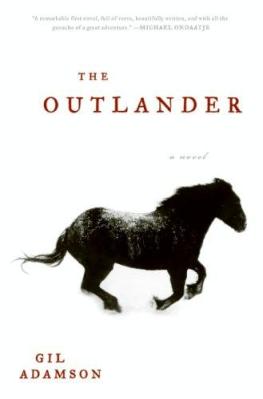There’s something great about a beautifully simplistic cover. It’s what made me pick up Gil Adamson’s The Outlander in the first place. More historical fiction for me.
I think I need to branch out.
———————
The Outlander by Gil Adamson
Ecco; First Edtion ; First Printing edition (April 15, 2008)

Courtesy of Amazon.com:
From Publishers Weekly Starred Review. Set in 1903, Adamson’s compelling debut tells the wintry tale of 19-year-old Mary Boulton ([w]idowed by her own hand) and her frantic odyssey across Idaho and Montana. The details of Boulton’s sad past—an unhappy marriage, a dead child, crippling depression—slowly emerge as she reluctantly ventures into the mountains, struggling to put distance between herself and her two vicious brothers-in-law, who track her like prey in retaliation for her killing of their kin. Boulton’s journey and ultimate liberation—made all the more captivating by the delirium that runs in the recesses of her mind—speaks to the resilience of the female spirit in the early part of the last century. Lean prose, full-bodied characterization, memorable settings and scenes of hardship all lift this book above the pack. Already established as a writer of poetry (Ashland) and short stories (Help Me, Jacques Cousteau), Adamson also shines as novelist. (Apr.)Copyright © Reed Business Information, a division of Reed Elsevier Inc. All rights reserved. From Booklist
Tracked by bloodhounds and pursued by brutal-looking redheaded twins, a gently reared young woman flees over the plains of western Canada and into the mountains. She hears voices and sees events that may or may not be happening, causing her and other characters in this stylistically complex novel to question her sanity. The widow (as she is called in the first eight chapters of the book) is rescued by strangers who allow her free passage on a ferry or give her sanctuary and one who starts her back toward reality and sanity. Adamson cleverly integrates techniques of the adventure-suspense novel with a refined, often poetic style. She maintains suspense while portraying the wilderness of Canada’s far west and providing fine portraits of the people who lived in and were shaped by it. The slow unfolding of story and character coupled with lyrical descriptions of the terrain, an occasional touch of bizarre humor, and a multitude of well-chosen historical details will appeal to readers of literary writing as well as historical- fiction fans. –Ellen Loughran
———————–
First, let me say this: I had not the first clue exactly where the book took place, and from the two reviews listed above, neither did anyone else. The book’s flap says “flees across the west.” Publisher’s Weekly says “Idaho and Montana.” Booklist says “The plains of western Canada.” There are no recognizable city names or landmarks to indicate a particular region, so where PW and Booklist got their ideas, I don’t know, unless they were connected with the author and/or I seriously missed something.
Before I discuss strengths and flaws, I have to go into Adamson’s style in this book, since I can’t really say if this particular element is a strength or a flaw. There is a deliberate (I think) remoteness in the narrative. You’re never sure where she is or how much time has passed. The author also refers to Mary (the protagonist) as “the widow” so frequently you almost forget what her name really is. Again, I think this creates a very deliberate, disconnected way of connecting with the widow’s state of mind. In that respect, I think it was actually a clever construction on Adamson’s part.
On a reader’s level, it irritated the hell out of me. I had a few of those “WHAT??!?!?!?” moments as I was reading and desperately trying to do some sort of mental time calendaring in my head. However, that may have been exactly Adamson’s intention, to bring the reader to the same feeling of remote disconnection as the characters in the book.
I have no idea. I’m discombobulated by it.
Strengths: Adamson’s descriptive powers are excellent. She depicts the widow’s flight vividly, without becoming too ponderously detailed. She also creates extremely vivid, memorable characters, particularly Mary’s twin brothers-in-law and McEchern the dwarf. If you regard the aforementioned remoteness as a strength, it’s wonderful, because she remains faithful to it throughout the book.
Potential Flaws: The primary difficulty a reader may have with this text is what I mentioned before: a purposeful creation of a sense of utter LOSTNESS (sorry to make up words, but it seems to fit in this case). I am very torn about how I feel about the technique. Am I irritated because I was completely taken in and buffaloed by it? Or am I irritated because it weakens the story? I was unsettled at the end, and I’m not entirely sure whose fault that is…
My Rating:
 -ISH?
-ISH?
I don’t know. I guess at the heart of it all, I saw a story that was intriguing, despite stylistic choices on the author’s part and my reaction to them. If you can appreciate a book written in a less-than-straightforward style, this may be the book for you. Ish.
No comments:
Post a Comment